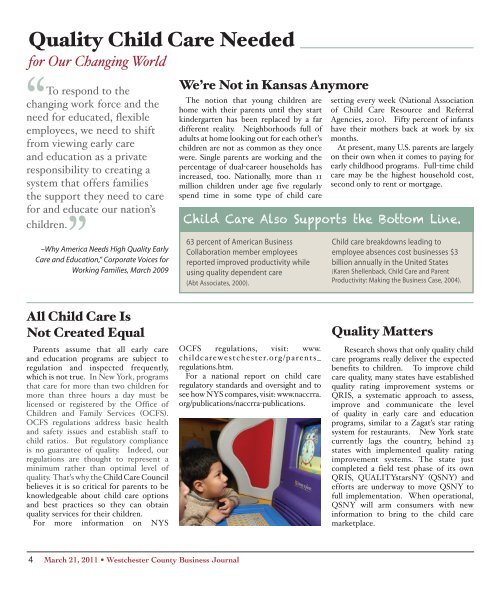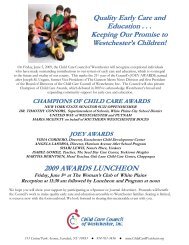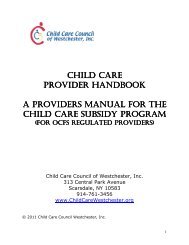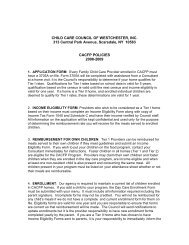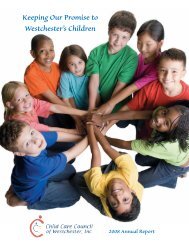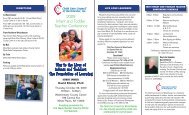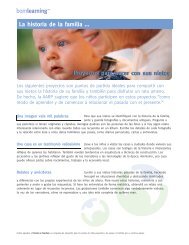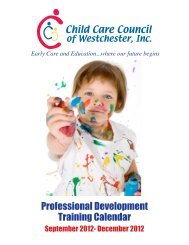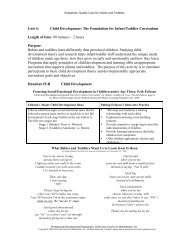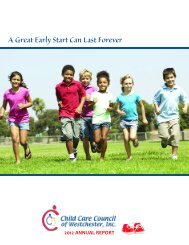Business Case for Early Childhood Investment - Child Care Council ...
Business Case for Early Childhood Investment - Child Care Council ...
Business Case for Early Childhood Investment - Child Care Council ...
You also want an ePaper? Increase the reach of your titles
YUMPU automatically turns print PDFs into web optimized ePapers that Google loves.
Quality <strong>Child</strong> <strong>Care</strong> Needed<br />
<strong>for</strong> Our Changing World<br />
“To respond to the<br />
changing work <strong>for</strong>ce and the<br />
need <strong>for</strong> educated, flexible<br />
employees, we need to shift<br />
from viewing early care<br />
and education as a private<br />
responsibility to creating a<br />
system that offers families<br />
the support they need to care<br />
<strong>for</strong> and educate our nation’s<br />
”<br />
children.<br />
–Why America Needs High Quality <strong>Early</strong><br />
<strong>Care</strong> and Education,” Corporate Voices <strong>for</strong><br />
Working Families, March 2009<br />
All <strong>Child</strong> <strong>Care</strong> Is<br />
Not Created Equal<br />
Parents assume that all early care<br />
and education programs are subject to<br />
regulation and inspected frequently,<br />
which is not true. In New York, programs<br />
that care <strong>for</strong> more than two children <strong>for</strong><br />
more than three hours a day must be<br />
licensed or registered by the Office of<br />
<strong>Child</strong>ren and Family Services (OCFS).<br />
OCFS regulations address basic health<br />
and safety issues and establish staff to<br />
child ratios. But regulatory compliance<br />
is no guarantee of quality. Indeed, our<br />
regulations are thought to represent a<br />
minimum rather than optimal level of<br />
quality. That’s why the <strong>Child</strong> <strong>Care</strong> <strong>Council</strong><br />
believes it is so critical <strong>for</strong> parents to be<br />
knowledgeable about child care options<br />
and best practices so they can obtain<br />
quality services <strong>for</strong> their children.<br />
For more in<strong>for</strong>mation on NYS<br />
4 March 21, 2011 • Westchester County <strong>Business</strong> Journal<br />
We’re Not in Kansas Anymore<br />
The notion that young children are<br />
home with their parents until they start<br />
kindergarten has been replaced by a far<br />
different reality. Neighborhoods full of<br />
adults at home looking out <strong>for</strong> each other’s<br />
children are not as common as they once<br />
were. Single parents are working and the<br />
percentage of dual-career households has<br />
increased, too. Nationally, more than 11<br />
million children under age five regularly<br />
spend time in some type of child care<br />
<strong>Child</strong> <strong>Care</strong> Also Supports the Bottom Line.<br />
63 percent of American <strong>Business</strong><br />
Collaboration member employees<br />
reported improved productivity while<br />
using quality dependent care<br />
(Abt Associates, 2000).<br />
OCFS regulations, visit: www.<br />
childcarewestchester.org/parents_<br />
regulations.htm.<br />
For a national report on child care<br />
regulatory standards and oversight and to<br />
see how NYS compares, visit: www.naccrra.<br />
org/publications/naccrra-publications.<br />
setting every week (National Association<br />
of <strong>Child</strong> <strong>Care</strong> Resource and Referral<br />
Agencies, 2010). Fifty percent of infants<br />
have their mothers back at work by six<br />
months.<br />
At present, many U.S. parents are largely<br />
on their own when it comes to paying <strong>for</strong><br />
early childhood programs. Full-time child<br />
care may be the highest household cost,<br />
second only to rent or mortgage.<br />
<strong>Child</strong> care breakdowns leading to<br />
employee absences cost businesses $3<br />
billion annually in the United States<br />
(Karen Shellenback, <strong>Child</strong> <strong>Care</strong> and Parent<br />
Productivity: Making the <strong>Business</strong> <strong>Case</strong>, 2004).<br />
Quality Matters<br />
Research shows that only quality child<br />
care programs really deliver the expected<br />
benefits to children. To improve child<br />
care quality, many states have established<br />
quality rating improvement systems or<br />
QRIS, a systematic approach to assess,<br />
improve and communicate the level<br />
of quality in early care and education<br />
programs, similar to a Zagat’s star rating<br />
system <strong>for</strong> restaurants. New York state<br />
currently lags the country, behind 23<br />
states with implemented quality rating<br />
improvement systems. The state just<br />
completed a field test phase of its own<br />
QRIS, QUALITYstarsNY (QSNY) and<br />
ef<strong>for</strong>ts are underway to move QSNY to<br />
full implementation. When operational,<br />
QSNY will arm consumers with new<br />
in<strong>for</strong>mation to bring to the child care<br />
marketplace.


